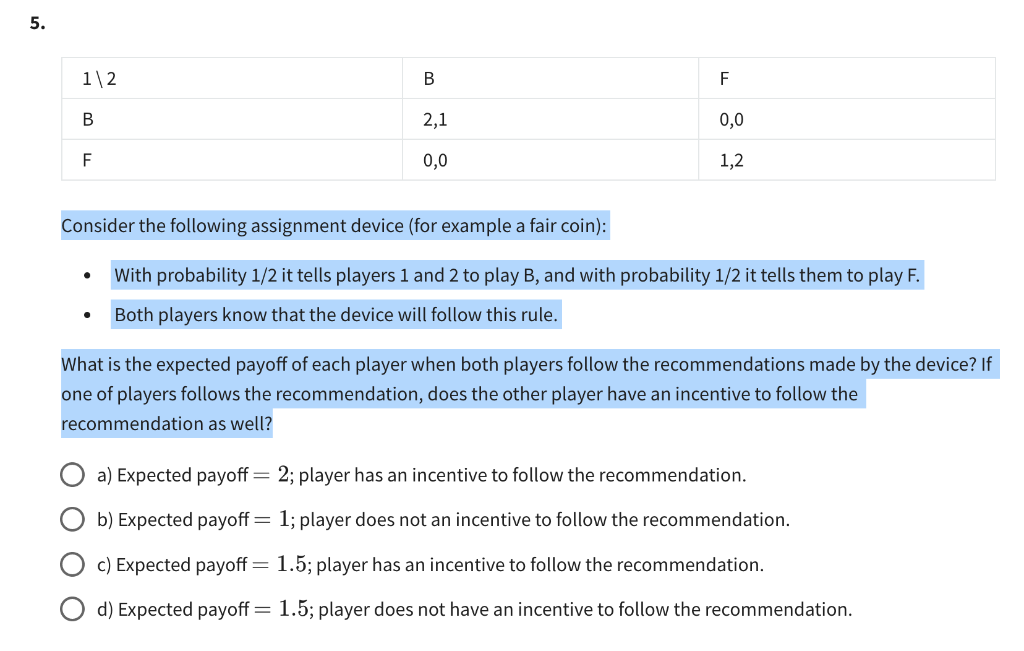0,0 1,2 Consider the following assignment device (for example a fair coin): With probability 1/2 it tells players 1 and 2 to play B, and with probability 1/2 it tells them to play F. Both players know that the device will follow this rule. What is the expected payoff of each player when both players follow the recommendations made by the device? If one of players follows the recommendation, does the other player have an incentive to follow the recommendation as well?
0,0 1,2 Consider the following assignment device (for example a fair coin): With probability 1/2 it tells players 1 and 2 to play B, and with probability 1/2 it tells them to play F. Both players know that the device will follow this rule. What is the expected payoff of each player when both players follow the recommendations made by the device? If one of players follows the recommendation, does the other player have an incentive to follow the recommendation as well?
Chapter16: Labor Markets
Section: Chapter Questions
Problem 16.9P
Related questions
Question
7

Transcribed Image Text:5.
B
1\2
B
2,1
0,0
F
0,0
1,2
Consider the following assignment device (for example a fair coin):
With probability 1/2 it tells players 1 and 2 to play B, and with probability 1/2 it tells them to play F.
●
Both players know that the device will follow this rule.
What is the expected payoff of each player when both players follow the recommendations made by the device? If
one of players follows the recommendation, does the other player have an incentive to follow the
recommendation as well?
a) Expected payoff = 2; player has an incentive to follow the recommendation.
b) Expected payoff = 1; player does not an incentive to follow the recommendation.
c) Expected payoff = 1.5; player has an incentive to follow the recommendation.
d) Expected payoff = 1.5; player does not have an incentive to follow the recommendation.
D
F
Expert Solution
This question has been solved!
Explore an expertly crafted, step-by-step solution for a thorough understanding of key concepts.
This is a popular solution!
Trending now
This is a popular solution!
Step by step
Solved in 3 steps with 1 images

Knowledge Booster
Learn more about
Need a deep-dive on the concept behind this application? Look no further. Learn more about this topic, economics and related others by exploring similar questions and additional content below.Recommended textbooks for you


Brief Principles of Macroeconomics (MindTap Cours…
Economics
ISBN:
9781337091985
Author:
N. Gregory Mankiw
Publisher:
Cengage Learning

Essentials of Economics (MindTap Course List)
Economics
ISBN:
9781337091992
Author:
N. Gregory Mankiw
Publisher:
Cengage Learning


Brief Principles of Macroeconomics (MindTap Cours…
Economics
ISBN:
9781337091985
Author:
N. Gregory Mankiw
Publisher:
Cengage Learning

Essentials of Economics (MindTap Course List)
Economics
ISBN:
9781337091992
Author:
N. Gregory Mankiw
Publisher:
Cengage Learning

Managerial Economics: A Problem Solving Approach
Economics
ISBN:
9781337106665
Author:
Luke M. Froeb, Brian T. McCann, Michael R. Ward, Mike Shor
Publisher:
Cengage Learning